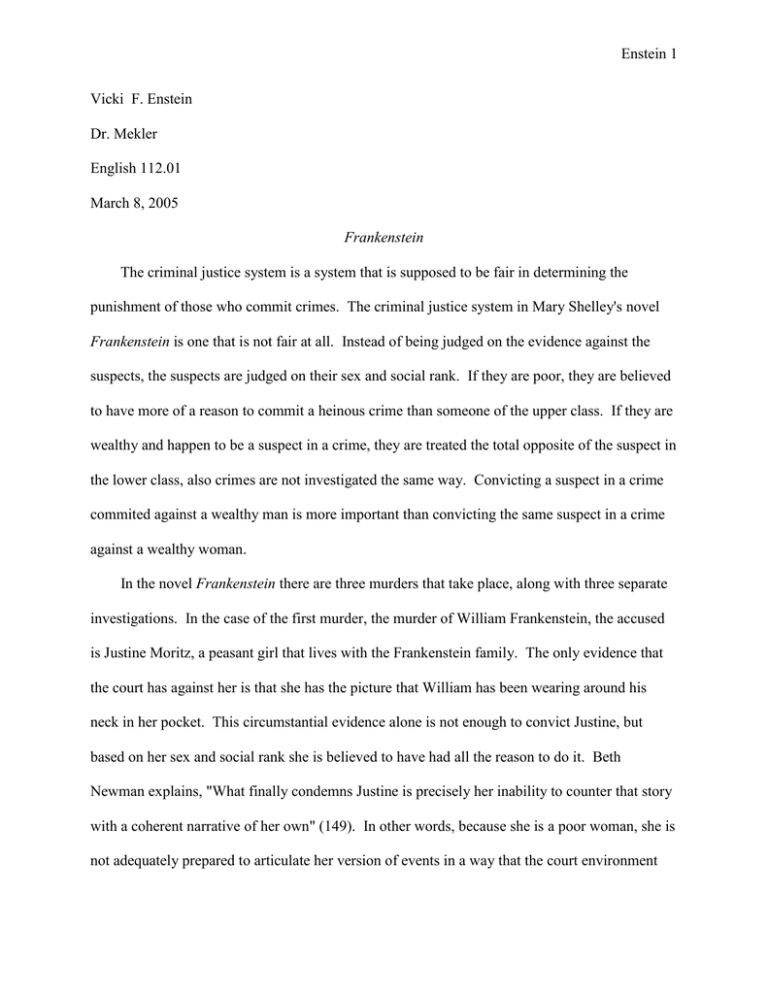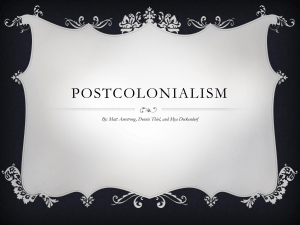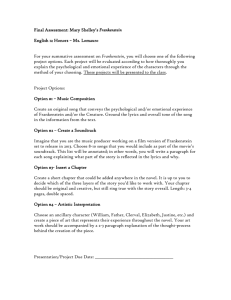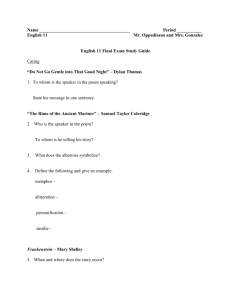Enstein 1 Vicki F. Enstein Dr. Mekler
advertisement

Enstein 1 Vicki F. Enstein Dr. Mekler English 112.01 March 8, 2005 Frankenstein The criminal justice system is a system that is supposed to be fair in determining the punishment of those who commit crimes. The criminal justice system in Mary Shelley's novel Frankenstein is one that is not fair at all. Instead of being judged on the evidence against the suspects, the suspects are judged on their sex and social rank. If they are poor, they are believed to have more of a reason to commit a heinous crime than someone of the upper class. If they are wealthy and happen to be a suspect in a crime, they are treated the total opposite of the suspect in the lower class, also crimes are not investigated the same way. Convicting a suspect in a crime commited against a wealthy man is more important than convicting the same suspect in a crime against a wealthy woman. In the novel Frankenstein there are three murders that take place, along with three separate investigations. In the case of the first murder, the murder of William Frankenstein, the accused is Justine Moritz, a peasant girl that lives with the Frankenstein family. The only evidence that the court has against her is that she has the picture that William has been wearing around his neck in her pocket. This circumstantial evidence alone is not enough to convict Justine, but based on her sex and social rank she is believed to have had all the reason to do it. Beth Newman explains, "What finally condemns Justine is precisely her inability to counter that story with a coherent narrative of her own" (149). In other words, because she is a poor woman, she is not adequately prepared to articulate her version of events in a way that the court environment Enstein 2 requires. William Veeder says "The cards seem stacked formidably against Justine from the start" (271). Meaning that even before the trial begins Justine is already judged guilty. Instead of being innocent until proven guilty, she is considered guilty and must prove her innocence. Justine is convicted of murder and sentenced to death. Even after being found guilty Justine is forced to confess to the murder by a confessor. He tells her that she would burn in hell if she did not confess to the murder (56). Not only was she found guilty and then forced to confess to the murder she is also thrown into a "gloomy prison chamber" with nothing but "straw to sit on"(55). Since Justine is at the bottom of the social class, the possibilities of the court looking for any other suspects is highly unlikely. They believe that because she was poor and not to mention a woman, she had more of a reason to commit the crime, and why would anyone kill a child over something so valuable only to part with it again so soon (53). Further, her alleged killing of William represents one of the worst crimes imaginable for someone of her class. As William Sayres explains, "Although not stated in the legal documents of the indictment, the crime for which Justine stands condemned in jurors' hearts is her 'blackest ingratitude' "(48). These are the things that are taken into account in the trial of Justine Moritz. With the second murder, the murder of Victor's friend Henry Clerval, Victor is the suspect, but his treatment is totally different from that of Justine. He is given the best room in the prison, a physician and a nurse, and is visited by the magistrate every now and again (124). He receives better treatment than Justine because of his sex and his social rank. Victor is an educated gentleman who comes from a wealthy family, They are not going to let anything happen to him while he is imprisoned. During Victor's trial he never sets foot in court. The magistrate collects all of the witnesses and also arranges his defense (126). There is no way that Victor can be convicted of this crime if one of the main magistrates is in control of his defense. He states that Enstein 3 "I was spared the disgrace of appearing publicly as a criminal ... the grand jury rejected the bill" (126). The grand jury has no choice but to reject the bill if there is no evidence against him. The third murder, the murder of Elizabeth Frankenstein (Victor's wife), is not even fully investigated. Victor is the only suspect, because he is the only person in the room when she is murdered. Out of all the people that surround Victor as he recovers from the shock of seeing his dead wife, nobody suspects Victor of killing her himself. Victor is in fact arrested for the murder only to be released several months later because he is presumed insane. In comparing these three trials we can come to a clear understanding of how the justice system in Frankenstein is based solely on gender and social status. In today's society we do not release people that are deemed insane by the courts back into the general population. As seen in the trials we discussed the treatment received by the male suspect (Victor Frankenstein) compared to the treatment received by the female suspect (Justine Moritz) are the total opposite with the trials having two diferent outcomes, even though both suspects are suspected of the same crime of "murder"(in Victor's case he is suspected twice), only one person is found guilty: the poor female Justine Moritz. Enstein 4 Works Cited Newman, Beth. "Narratives of Seduction and the Seductions of Narrative: The Frame Structure of Frankenstein." English Literary History 53 (1986): 141-61. Repr. in Frankenstein/Mary Shelley. Ed. Fred Botting. New York: St. Martin's, 1995. 166-90. University of Pennsylvania On-line Database. <http://www.english.upenn.edu/knarf/Articles/newmanb.html>. 8 March 2005. Sayres, William G. . "Compounding the Crime: Ingratitude and the Murder Conviction of Justine Moritz in Frankenstein." English Language Notes. 31.4 (June 1994): 48-54. University of Pennsylvania On-line Database. <http://www.english.upenn.edu/knarf/Articles/sayres.html>. 8 March 2005. Shelley, Mary. Frankenstein (Case Studies in Contemporary Criticism). 2nd Edition. Ed. Johanna Smith. NY: St. Martins, 2000. Veeder, William. "The Women of Frankenstein." Mary Shelley/Frankenstein. Ed. J. Paul Hunter. NY: Norton, 1996. 271-73. Questions to Consider: What is the main thesis of the paper? Does the author adequately support it? Does the person stay on the original topic? Present a passage that does not seem to belong and could be eliminated. Find two examples of quotation in the essay, one each from the primary source and a secondary source. Does the writer properly cite the quotes? Do the quotes adequately fit in to the discussion where they are found? Do they support the writer's claims? Explain. Are there parts of the paper that are difficult to understand? Explain. Are sources presented in proper MLA format? Are there any that need to be corrected? Make specific suggestions.



